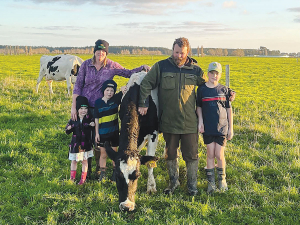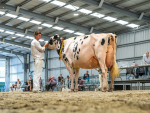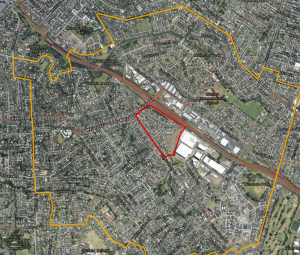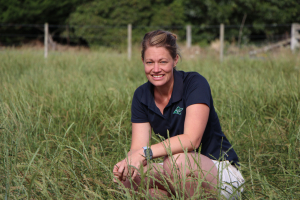Scott and Maree Bixley, of Kaylen Holstein Friesian stud in Tussock Creek, moved their farm business from the Waikato six years ago.
"Farming in the Waikato was tough, so a good friend farming in Southland encouraged us to come down 'for a bit of a look'," Maree says.
They bit the bullet and today they are milking 350 cows on 142ha, with a 28ha support block next door; Scott and Maree are in an equity partnership with Scott's parents, Russell and Lynda.
Scott was brought up in Pukekohe, the son of an accountant, and Maree on a dairy farm in Maramarua.
"Dad always wanted to be a dairy farmer but decided to continue working as an accountant and still is today," Scott says.
With aunts and uncles dairy farming, Scott dairy farmed in the Waikato for some years. He and Maree 50/50 sharemilked 180 cows at Morrinsville, and then 50/50 sharemilked 410 cows at Otapiri.
They then moved to a position in Kindley Downs at Clydedale, where they 50/50 sharemilker 780 cows.
"We went from 180 cows to 780 cows in two years," Scott says.
The original herd they bought was made up of Jersey cattle, but within two years they had sold the Jerseys and replaced them with Holstein Friesian cows. During that time they bought crossbred animals which they later sold to a Southland farmer.
Today, the herd is 70-80% Holstein Friesian.
Maree says they decided to farm Holstein Friesian cattle because they are hardy, they have a good temperament, and there is a market for surplus stock.
"We are also looking for cows who do the job for us," Maree says. "We are sitting at production of 190,000 kgMS but we want to do a lot better. We've had a few curveballs thrown at us since moving here, but we're getting there."
Wet weather has meant pugging can be an issue, but the couple has commissioned work on a Smart Shelter, which will take the pressure off in spring.
The Bixleys feed one tonne/cow through the shed and buy in baleage to feed in winter, rather than grazing crops.
Calving starts on August 21, with around 80 replacements kept.
"Any extra, we send up to China," Scott says. "We also sell 50 beef weaners every year."
Mating starts on November 11; Scott is an AB technician, and they use STgenetics' Chromosomal Mating Programme, while still picking their own bulls.
"We use semen from STgenetics, World Wide Sires and Semen," Scott says.
Half the herd is bred from, while the rest is put to beef. For the dairy herd, they use sexed semen for the first four-five weeks, followed by one week of conventional Holstein Friesian semen. After that, any returning cows are put to Belgian Blue or short gestation crossbred bulls from LIC for a final week.
Scott says they have used Edg Rubicon-ET in recent seasons and have good daughters coming through.
"We've also used bulls from the Maire herd, including Maire Oman Franklin," he says. "We have twins who are retired now at 16-years-old but have contributed hugely to the herd, with 26 descendants between them. Some of their daughters are by Franklin."
When the Bixleys were selling the Jersey herd out, they put "big bull" Tomlu Oman Dotson-ET over "a pretty rubbish Jersey cow".
"The result was an animal that grew and grew and ended up with ful Holstein Friesian markings, and was built like a train," Scott says. "She had daughters to Ladys-Manor Pl Shamrock-ET and Seagull-Bay Supersire-ET.
"We also bought a group of in-calf heifers from Roger and Sue Jenkins (Membury Stud) with small udders and fantastic temperament."
Scott says their ideal cow is a big, Holstein cow that produces the milk of two cows.
"We want the litres, capacity, and strength that comes from a big cow," Scott says. "We want to milk fewer cows, so we really pick on udders, size, litres and components to create an efficient cow."
Future Plans
Looking to the future, they would like to buy Scott's parents out, and milk fewer cows.
"We'd like to milk less cows while maintaining peak production," Maree says.
"Scott and I are full time on the farm over calving and mating, with one full time staff member, so we'd like to make it easier."
The farm, JTK Farms Ltd, is named for the Bixleys' children, Jayden (9), Tyler (7) and Katelyn (4). Kaylen is also an amalgamation of their names.
And Scott's parents Russell and Lynda are looking to sell up and join them in the South Island.
"Dad and I do have battles, him being an accountant and me being a farmer, but we both want to make money, have fun, and do the breeding thing," Scott says. "We're setting up the business for the kids as well, to secure their future."
Scott and Maree say two people have had a big influence on them since they moved to Southland: breeder and Southland HFNZ Life Member Brian Perkins of Fernlea Stud, and STgenetics' John Bannatyne.
"Brian convinced us that our cows were better than we thought they were and encouraged us to enter the HFNZ- Semex On Farm Otago/Southland Two-Year-Old class with Kaylen M-Leche Alice S1F," Scott sas. "And John has been there to help us shape the herd to our breeding goals and preferences.
"We want to enjoy looking out the window at our herd and have a herd that, when people walk through it, say, 'I want these cows'. We want a herd we can be proud of."


















